REGIONAL OVERVIEW
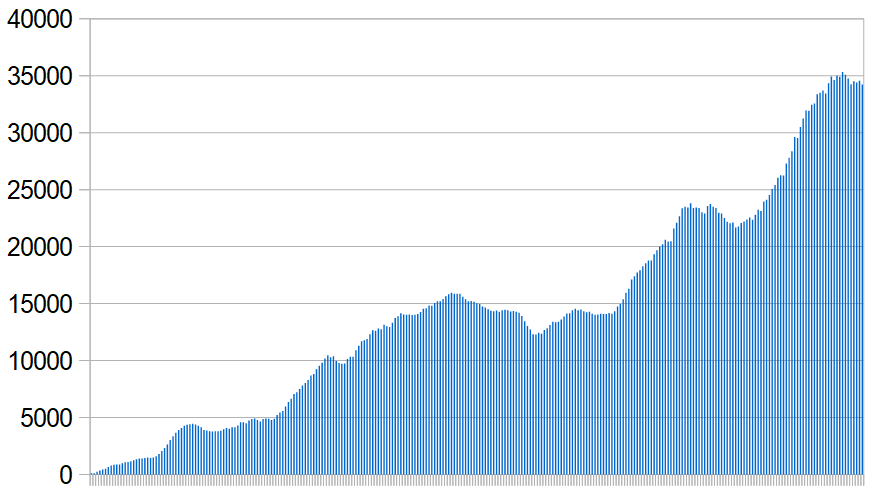 |
A million new cases of Covid-19 were recorded in the Middle East and North Africa during November, bringing the region's total since the pandemic began to more than four million. To put it another way, a quarter of all known Covid-19 infections in the region have occurred during the past month.
Among the 20 countries monitored, Iran recorded the largest number of new infections during November, followed by Jordan and Morocco.
At the other end of the scale, Syria, Sudan and Yemen reported very low numbers but the official figures from those countries are widely regarded as unreliable.
The list below shows the daily average of new Covid-19 infections reported by each country during November:
| Iran Jordan Morocco Iraq Lebanon Tunisia UAE Palestine Algeria Israel Libya Kuwait Saudi Oman Egypt Qatar Bahrain Sudan Syria Yemen |
11,460 4,833 4,617 2,660 1,581 1,274 1,208 1,068 819 743 727 570 342 302 272 210 177 120 70 4 |
The list below shows the change in the daily average, comparing November with October:
| Iran Jordan Morocco Algeria Palestine Lebanon Egypt Sudan Syria Yemen Qatar UAE Tunisia Saudi Kuwait Libya Bahrain Oman Iraq Israel |
+6,579 +2,922 +1,581 +616 +596 +253 +134 +115 +30 +3 -10 -31 -36 -68 -100 -132 -179 -210 -964 -1,734 |
It can be seen from this that Iran recorded the biggest rise in new infections, followed by Jordan and Morocco. Israel, where a second wave of infections has now subsided, recorded the biggest decrease.
Most countries in the region are making preparations for the arrival of vaccines and several have been taking part in vaccine trials. Some – mostly the wealthier ones – have struck deals with major pharmaceutical companies, often for more than one type of vaccine. Others are relying on the international Covax initiative and some are making use of both methods. See this article for details of the preparations.
● Previous regional updates: November 1; October 3; September 26; September 19; September 12; September 5; August 29; August 22; August 15; August 8; August 1; July 25; July 18; July 11; July 4; June 27; June 20.
● Official figures from around the region can be found in the statistical spreadsheet which is updated daily.
ALGERIA
Algeria's outbreak first peaked towards the end of July when more than 600 new infections were being recorded each day. Numbers declined through August and September, reaching a low point of around 134 cases a day in the second week of October, according to the official figures. Since then, though, they have risen to new heights, averaging more than 1,000 new cases a day during the past week.
For more information see: Covid-19 in Algeria
Confirmed cases: 82,221
Active cases: 26,959
Deaths: 2,431
Tests carried out: (unknown)
BAHRAIN
After several ups and downs, Bahrain's outbreak reached a peak in the third week of September when new cases were averaging more than 700 a day. There has been a steady drop since then and new cases in the past week averaged 155 a day.
For more information see: Covid-19 in Bahrain
Confirmed cases: 86,787
Active cases: 1,474
Deaths: 341
Tests carried out: 2.1 million
EGYPT
Official figures show Egypt's outbreak has has been relatively stable since early August. This week's average was 359 new cases a day compared with almost 1,600 a day at the peak in June.
The official figures are surprisingly low considering Egypt's large population (103 million).
For more information see: Covid-19 in Egypt
Confirmed cases: 115,541
Active cases: 6,543
Deaths: 6,650
Tests carried out: 1 million
IRAN
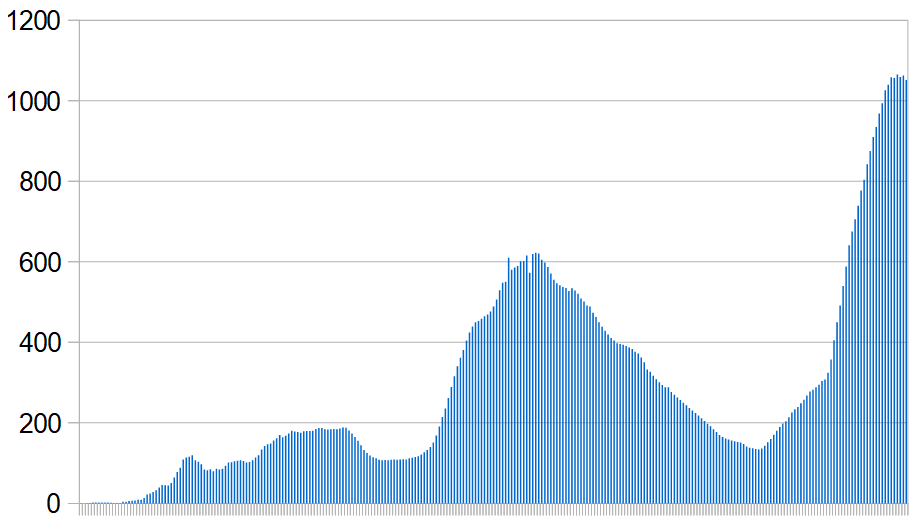 |
Iran was the first country in the region to be seriously affected by the virus. An initial wave of infections peaked at the end of March, briefly subsiding during April. A huge second wave struck towards the end of September and is still continuing. Officially-recorded new infections – currently the highest in the region – are running at more than 30,000 a day.
Iran has reported more coronavirus-related deaths than any other country in the region.
Confirmed cases: 948,749
Active cases: 245,673
Deaths: 48,246
Tests carried out: 6.1 million
IRAQ
Iraq's epidemic appears to have developed relatively late. It was not until the second half of May that new cases rose above 100 a day, though that may have been due to a lack of detection.
The official figures show 2,159 new cases a day during the past week – well below the September peak – but they are widely believed to understate the scale of the epidemic. Many cases go unreported because of social stigma. Compliance with preventive measures is reported to be low and health services are inadequate.
For more information see: Covid-19 in Iraq
Confirmed cases: 550,435
Active cases: 57,617
Deaths: 12,258
Tests carried out: 3.5 million
ISRAEL
Israel's first wave peaked at around 600 new cases a day in early April. Efforts to control it were intially successful and by the second half of May new cases had dropped to about 15 a day.
However, the virus surged back when lockdown restrictions were lifted and by the end of September the country was in the midst of a second wave – much higher than the first – with new infections hovering around 6,000 a day.
A second nationwide lockdown began on September 18 and continued for a month, greatly reducing the number of new infections. There was a slight upturn again in November, with new cases averaging 940 a day during the past week.
For more information see: Covid-19 in Israel
Confirmed cases: 335,980
Active cases: 10,232
Deaths: 2,865
Tests carried out: 5.6 million
JORDAN
For several months Jordan appeared to be the most successful Arab country in controlling the virus. Local transmission had virtually ceased and almost all the new cases were detected among people arriving from abroad.
The level of new infections remained very low until mid-September when it began rising rapidly. A record number of 5,679 new infections was reported on November 23 but the number has dropped slightly every day since then, suggesting the worst may now be over.
For more information see: Covid-19 in Jordan
Confirmed cases: 214,307
Active cases: 61,653
Deaths: 2,751
Tests carried out: 2.6 million
KUWAIT
New infections peaked in late May at just over 1,000 cases a day. Since then the numbers have fluctuated between 500 and 800 a day. During the last week of November new cases dropped below 500 a day for the first time since May and are currently averaging 339 a day.
For more information see: Covid-19 in Kuwait
Confirmed cases: 142,426
Active cases: 4,684
Deaths: 880
Tests carried out: 1.1 million
LEBANON
 |
Numbers of confirmed cases began rising significantly towards the end of July. A two-week lockdown which began in mid-August had little effect and numbers have continued to rise. The average during the past week was 1,495 new cases a day.
Lebanon's outbreak has occurred against a background of political and economic turmoil, plus the devastating explosion in Beirut on August 4. In the midst of this chaos the government has lacked a clear strategy for dealing with the virus. Preventive measures have been ineffective due to poor implementation and non-compliance, and there are said to have been problems with contact tracing.
For more information see: Covid-19 in Lebanon
Confirmed cases: 126,944
Active cases: 43,892
Deaths: 1,018
Tests carried out: 1.6 million
LIBYA
Libya is in its tenth year of internal conflict. The UN-backed Government of National Unity in Tripoli is challenged by Field Marshall Haftar's forces based in the east of the country. There are also numerous militias. This leaves the country ill-equipped to cope with a major epidemic. Growing levels of insecurity, political fragmentation and weak governance have led to a deterioration of basic services, particularly in the health system. At least 28 health facilities have been damaged or closed by fighting and some have been attacked directly.
Official figures show new Covid-19 infections currently averaging 658 a day during the past week but the true scale of Libya's outbreak is likely to be much higher.
For more information see: Covid-19 in Libya
Confirmed cases: 82,430
Active cases: 27,808
Deaths: 1,183
Tests carried out: 432,000
MOROCCO
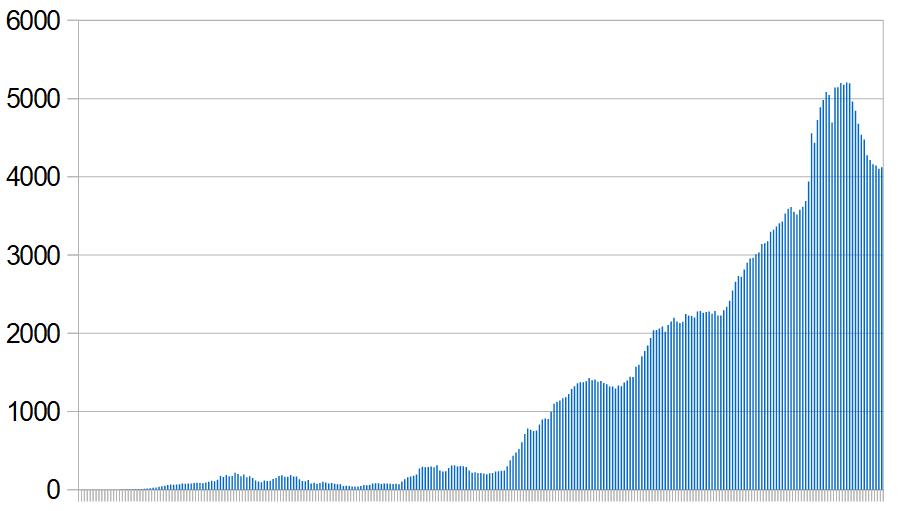 |
Morocco had some success during the early stages of the outbreak and by early June a strict lockdown had reduced new cases in Morocco to around 40 a day. New cases began increasing rapidly towards the end of July, however, and the situation has continued to worsen since then. By mid-November the country was recording more that 5,000 new cases a day, though there has since been a modest drop. The average during the past week has been 4,123 cases a day.
For more information see: Covid-19 in Morocco
Confirmed cases: 353,803
Active cases: 45,199
Deaths: 5,846
Tests carried out: 4 million
OMAN
New infections peaked in mid-July with just under 1,600 cases a day but dropped back sharply in August. There have been a few rises and falls since then, but not to the previous level. New infections reported during the past week averaged 200 a day.
For more information see: Covid-19 in Oman
Confirmed cases: 123,484
Active cases: 7,060
Deaths: 1,423
Tests carried out: 571,000
PALESTINE
Palestine's outbreak reached a peak in the third week of September when almost 900 new cases were being recorded daily. It then subsided for a while before rising to new heights. During the last week of November new cases averaged 1,778 a day.
For more information see: Covid-19 in Palestine
Confirmed cases: 98,850 (West Bank 65,001, Gaza 20,6465, East Jerusalem 13,203)
Active cases: 19,928
Deaths: 732
Tests carried out: 667,000
QATAR
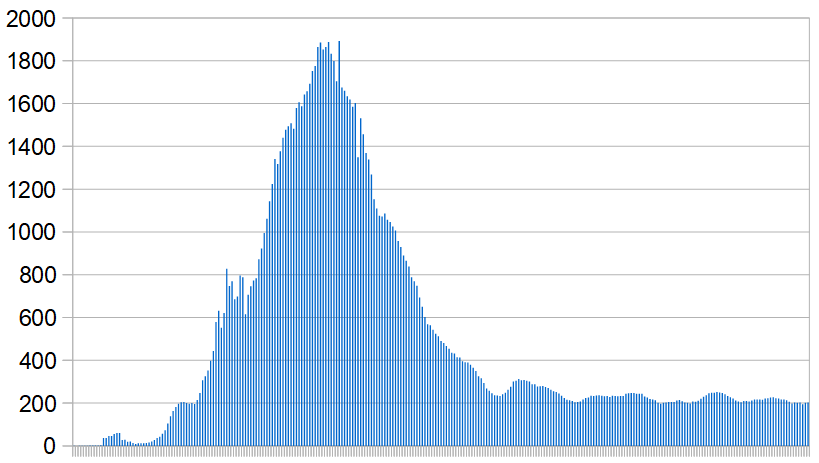 |
Qatar's outbreak peaked in early June with just under 1,900 cases a day. Since the beginning of August the numbers of new cases have been relatively steady, ranging between 200 and 300 a day. The average during the past week was 202 a day.
For more information see: Covid-19 in Qatar
Confirmed cases: 138,646
Active cases: 2,506
Deaths: 237
Tests carried out: 1.1 million
SAUDI ARABIA
New infections reached an initial peak in the fourth week of May then dropped back slightly before rising to a higher peak in the third week of June when new cases came close to 5,000 a day.
Since then, though, there has been a substantial improvement. New cases dipped below 500 a day at the end of September and continued on a gradual downward path through October and November. The past week's average was 267 a day.
Saudi Arabia has the largest number of recorded cases among the Arab countries.
For more information see: Covid-19 in Saudi Arabia
Confirmed cases: 357,128
Active cases: 4,662
Deaths: 5,896
Tests carried out: 9.6 million
SUDAN
The coronavirus struck Sudan in the midst of a political transition following a popular uprising against the regime of President Bashir and the country is ill-equipped to cope with a major epidemic. Testing is very limited and official figures don't reflect the full scale of the outbreak. The health ministry appears to have stopped issuing daily reports.
Covid-19 is only one among a number of infectious diseases causing problems in Sudan.
For more information see: Covid-19 in Sudan
Confirmed cases: 17,404
Active cases: 6,259
Deaths: 1,249
Tests carried out: (unknown)
SYRIA
According to official figures fewer than 8,000 cases have been recorded in areas controlled by the Assad regime. Considering the situation in neighbouring countries this extremely low figure seems implausible and the authorities' lack of transparency fuels suspicions that many cases are being concealed. There is also some evidence that people with Covid-19 symptoms are reluctant to contact the authorities.
For more information see: Covid-19 in Syria
The following figures relate to regime-controlled areas only:
Confirmed cases: 7,797
Active cases: 3,910
Deaths: 417
Tests carried out: 26,572 (by 24 August)
TUNISIA
In June, Tunisia appeared to be almost free of the virus and began promoting itself as a safe holiday destination. Since August, though, new infections have increased substantially. During the past week they averaged 1,077 a day.
For more information see: Covid-19 in Tunisia
Confirmed cases: 96,251
Active cases: 22,658
Deaths: 3,260
Tests carried out: 460,000
UNITED ARAB EMIRATES
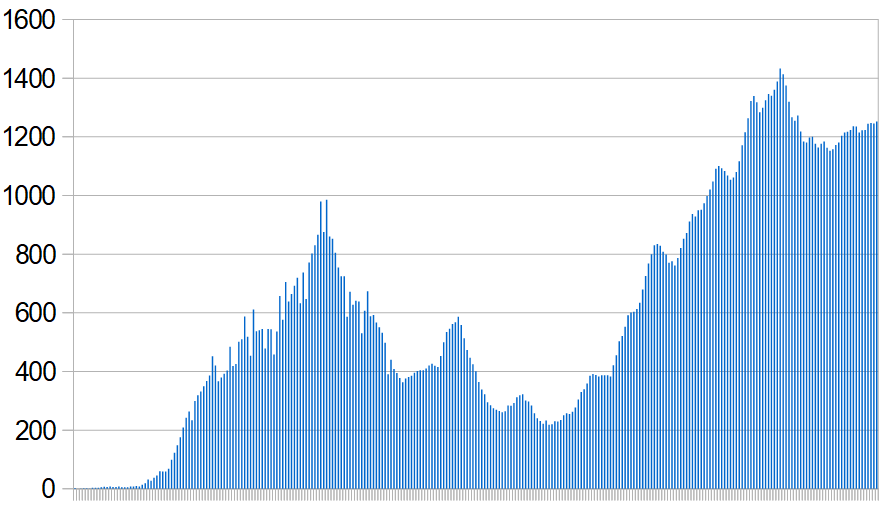 |
The UAE's epidemic reached an initial peak in May when new infections were running at more than 900 a day. A second wave struck in September, reaching a peak at the end of October. New cases during the past week they averaged 1,252 a day – slightly below the October peak.
For more information see: Covid-19 in the UAE
Confirmed cases: 167,753
Active cases: 13,389
Deaths: 572
Tests carried out: 16.7 million
YEMEN
There have almost certainly been a lot more Covid-19 cases than shown by official figures.
Because of the ongoing war, Yemen already faced a humanitarian crisis before the coronavirus arrived. Millions are malnourished and vulnerable to disease, and health services are inadequate. Diseases that are rare in better-off countries, such as cholera, diphtheria, dengue fever and chikungunya, are common in Yemen.
For more information see: Covid-19 in Yemen
Confirmed cases: 2,181
Active cases: 62
Deaths: 620
Tests carried out: (unknown)

 RSS Feed
RSS Feed
